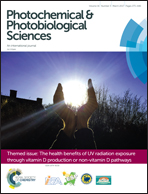A short history of phototherapy, vitamin D and skin disease
Abstract
The earliest record between sun exposure and skin disease goes back five millennia to the ancient Egyptians. The modern scientific era of medical light therapy and skin diseases started in 1877 when Downs and Blunt reported that exposure to light inhibited fungal growth in test tubes. Continuing research generated a growing medical interest in the potential the effects of light to treat and cure skin diseases considered as parasitic. This culminated in the awarding of the 1903 Nobel Prize in Medicine to Niels Finsen for his pioneering work showing that light could successfully treat cutaneous mycobacterium tuberculosis (lupus vulgaris), a disfiguring disorder common at the time. Cod liver oil was used as a folk remedy to treat rickets prior to 1789 in Manchester, UK and sunlight was published as the cure for this disease in 1921. The work by Hess and Weinstock in 1925 showed that food irradiated with ultraviolet (UV) light prevented rickets in rats, which paved the way for the discovery of vitamin D. The range of skin diseases treated by light therapy increased in the following years, to the point where a 1932 review by the American Medical Association on the use of UV therapy in dermatology listed 34 skin conditions for which UV radiation may be useful. This period coincided with the development of sanatoria in Europe and North America which used heliotherapy for the treatment of tuberculosis. UV therapy and vitamin D continued to be used successfully for the treatment of tuberculosis up to the 1950s when it was superseded by more effective antibiotics. Modern phototherapy developed in the 1980s with the discovery of the action spectrum for psoriasis leading to the development of narrow band UVB. Subsequently a biological mechanism by which UV light and vitamin D treated tuberculosis was identified in 2006. This involves activation of human macrophages via toll-like receptors to upregulate the vitamin D receptor gene resulting in induction of the antimicrobial peptide cathelicidin. The role of UV light and vitamin D in the treatment of skin diseases is currently an active area of research.

- This article is part of the themed collections: 2017 Perspective articles collection and The health benefits of UV radiation exposure through vitamin D production or non-vitamin D pathways

 Please wait while we load your content...
Please wait while we load your content...